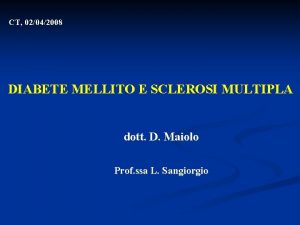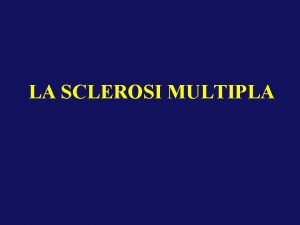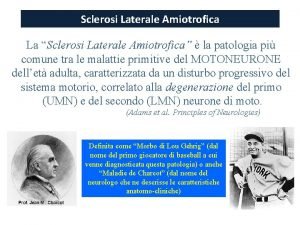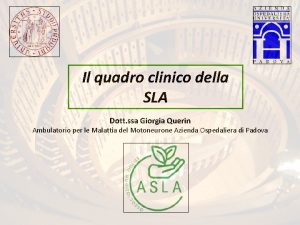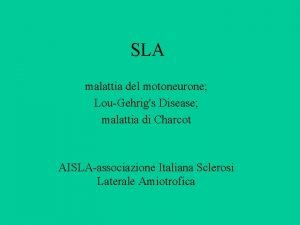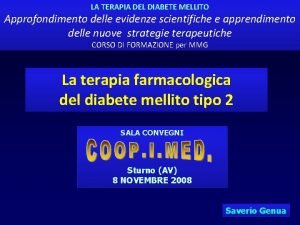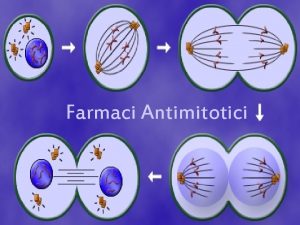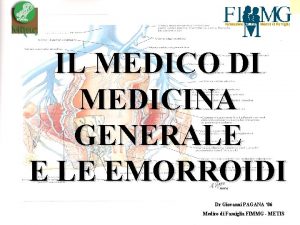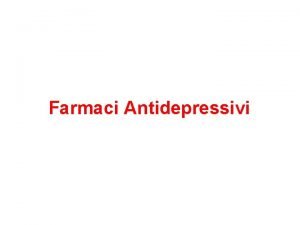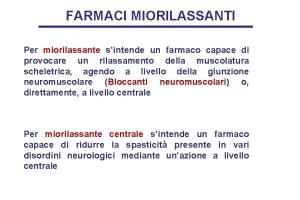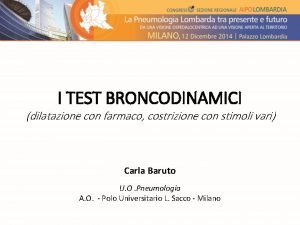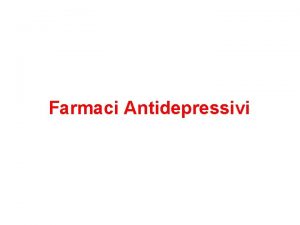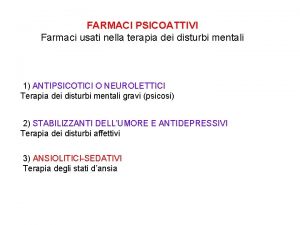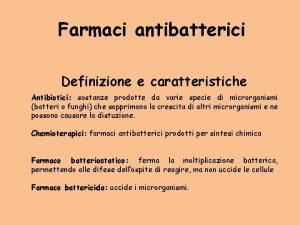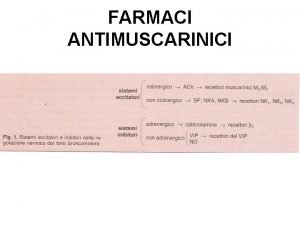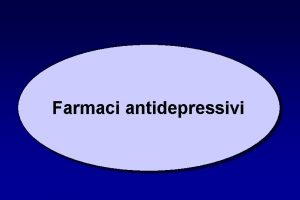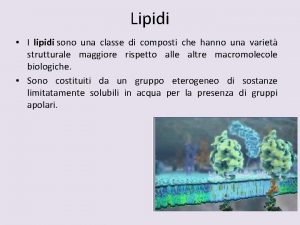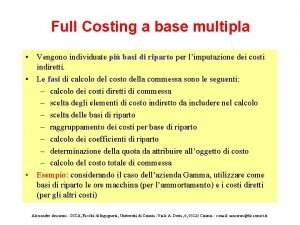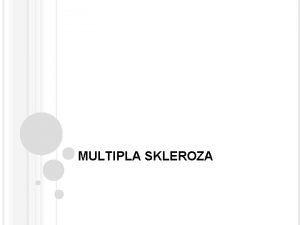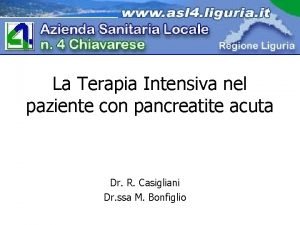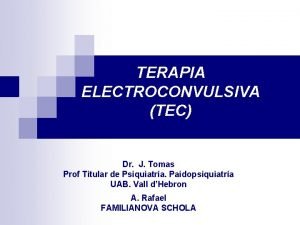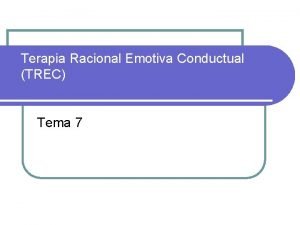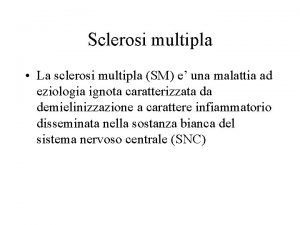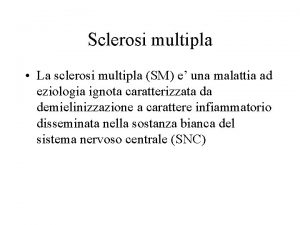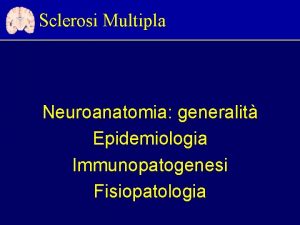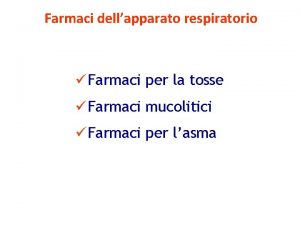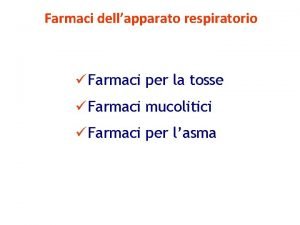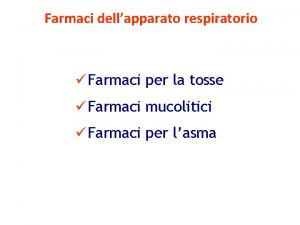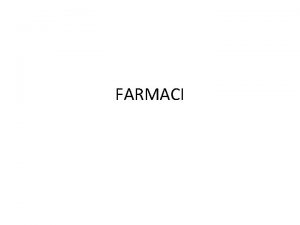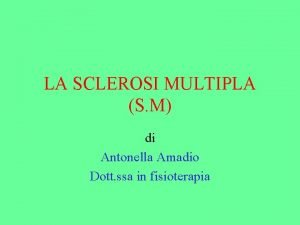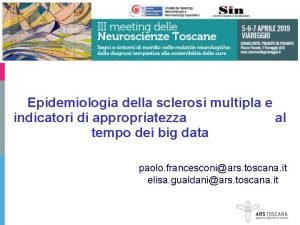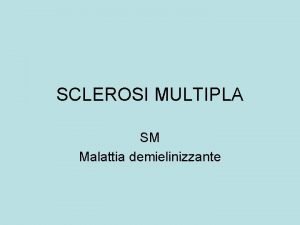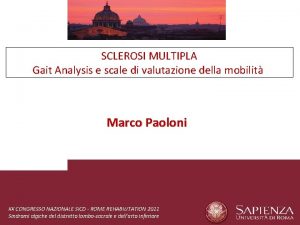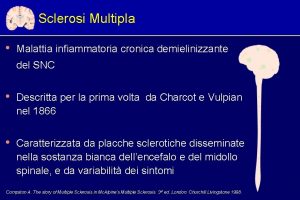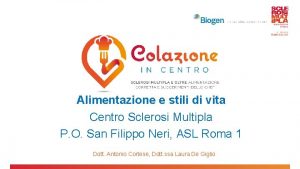NUOVI FARMACI E TERAPIA PERSONALIZZATA NELLA SCLEROSI MULTIPLA



















































- Slides: 51

NUOVI FARMACI E TERAPIA PERSONALIZZATA NELLA SCLEROSI MULTIPLA Dott. ssa Livia Pasquali Dipartimento di Medicina Clinica e Sperimentale U. O. C Neurologia Università di Pisa

Timeline of developments in the treatment of multiple sclerosis Tintore et al. , Nat Rev Neurol. 2019; 15(1): 53 -58.

Lemtrada® (Alemtuzumab) (First course: 12 mg daily for 5 days, Second course (12 months later): 12 mg daily for 3 days Up to two additional courses, each of 12 mg daily for 3 days, can be given at 12 -month intervals).

Alemtuzumab: Mechanism of Action LEMTRADA is a humanized monoclonal antibody that binds to CD 52, a cell-surface antigen present on T and B cells There are three mechanisms by which alemtuzumab mediates immune cell depletion : -antibody-dependent cell-mediated cytotoxicity; -complement-dependent cytotoxicity; -apoptosis In vitro experiments showed that antibody-dependent cell-mediated cytotoxicity occurs at much lower concentrations of alemtuzumab (0. 01 mg/m. L) than the concentration required for complement-dependent cytotoxicity and apoptosis.

Alemtuzumab q. After alemtuzumab administration to MS patients, depletion of CD 52+ cells is observed, mostly lymphocytes, followed by repopulation occurring: -after about 3 months for monocytes and B cells -after 30 months for CD 8+ T cells -after 61 months for CD 4+ T cells q The changed proportions in immune cells also include an increased number of Tregs and memory T and B cells q. Predominant regulatory T cells also create a “tolerogenic” environment after alemtuzumab application. q. Long-time CD 4+ cell depletion is considered the most important for therapeutic effect of alemtuzumab.

ALEMTUZUMAB: indicazioni terapeutiche �LEMTRADA è indicato per i pazienti adulti con sclerosi multipla recidivante-remittente (SMRR) con malattia attiva definita clinicamente o attraverso le immagini di risonanza magnetica

CARE-MSI and II (phase III) -CARE-MSI trial enrolled treatment naïve patients with early RRMS. -CARE-MSII trial enrolled previously treated patients with RRMS. -Annual cycles of intravenous alemtuzumab at 12 mg/d or three times per week subcutaneous INF-β 1 a at 44 μg that was followed for 24 months.

CARE-MS I and II: Results • CARE-MS I: 55% reduction in relapse rate in the alemtuzumab-treated group compared to the INFβ 1 a group at 24 months • CARE-MS II: 49% reduction in relapse rate in the alemtuzumab-treated group compared to the INFβ 1 a group at 24 months

ALEMTUZUMAB Dubey D et al. , Neuropsychiatr Dis Treat. 2015

Estensione a 5 anni di CARE-MSI: confirmed disability improvement Through 5 years, 75. 1% of patients were free of 6 -month CDW (confirmed disability worsening ) Havrdvova E et al. , Neurology 2017

Estensione a 5 anni di CARE-MSI: NEDA (no evidence of disease activity) 52. 9% 54. 2% 58. 2% NEDA - No relapses - No increase in disability (measured by EDSS) - No new or active (enhancing) lesions on MRI scans. Havrdvova E et al. , Neurology 2017

Estensione a 5 anni di CARE-MSII Havrdvova E et al. , Neurology 2017

Estensione a 5 anni di CARE-MSII Brain volume loss over 5 years in alemtuzumab patients Havrdvova E et al. , Neurology 2017

Alemtuzumab: effetti collaterali qtubercolosi attiva e latente, listeriosi/Listeria meningitis, candidiasi q. Non sono stati riportati casi di PML Havrdvova E et al. , Neurology 2017

Alemtuzumab: infusion associated reactions (IARs) q. The reactions generally include headache, rash, pyrexia, nausea, flushing, urticaria, insomnia and pruritus. q. More than 10% of patients in the Phase III studies showed cardiac disorders, in particular tachycardia. q It is thought that the IARs are due to allergic reactions of hypersensitivity mediated by immunoglobulin E and nonallergic cytokine release reactions induced by the recruitment of inflammatory cells or cell lysis. q. IARs decreased with each annual course of treatment and with subsequent infusions within a course.

Ocrevus® (Ocrelizumab) -600 mg dose is administered as two separate intravenous infusions, day 1 and day 15 -subsequent doses as a single 600 mg intravenous infusion (every 6 months)

Ocrelizumab: mechanism of action Ocrelizumab depletes pre-B cells, immature B cells, mature B cells and memory B cells by antibody-dependent cellular cytotoxicity (ADCC) and complementdependent cytotoxicity (CDC), but not lymphoid stem cells and plasma cells Bigaut, et al. , Expert Review of Neurotherapeutics, 2018

Status of ocrelizumab Approved by the FDA on 28 March 2017 for RRMS and PPMS, by the EMA on 8 January 2018 and by Health Canada on 14 February 2018 for RRMS with active disease and for early PPMS. FDA: ‘Ocrelizumab is indicated for the treatment of adult patients with relapsing or primary progressive forms of multiple sclerosis. ’ EMA: ‘Ocrelizumab is indicated for the treatment of adult patients with relapsing forms of multiple sclerosis (RMS) with active disease defined by clinical or imaging features. Ocrelizumab is indicated for the treatment of adult patients with early primary progressive multiple sclerosis (PPMS) in terms of disease duration and level of disability, and with imaging features characteristic of inflammatory activity. ’

B Cell Depletion: Anti-CD 20 Therapy Ocrelizumab RA Study 1 Rituximab MS Study 2 CD 19+ B Cells 0. 8 Counts (109/L) 0. 7 0. 6 0. 5 0. 4 0. 3 0. 2 0. 1 0 0 1 3 6 Month • Chronic anti-CD 20 treatment with ocrelizumab results in persistent immunosuppression, under which B cells remain depleted • The long-term consequences of anti-CD 20 treatment with ocrelizumab in patients with MS are unknown 1. Adapted from Genovese, et al. Arthritis Res Ther. 2013; 15(suppl 1): S 4; 2. Bar-Or A, et al. Ann Neurol. 2008; 63: 395 -400.

Baseline Characteristics in 2 -Year Core Studies: Ocrelizumab vs SC IFNß-1 a Clinical trial Trial IFN ß-1 a OPERA II Number of Patients 411 410 418 417 Female sex (%) 66. 2 65. 9 67. 0 65. 0 Baseline EDSS 2. 75± 1. 29 2. 86± 1. 24 2. 84± 1. 38 2. 78± 1. 30 Mean relapses in prior year 1. 33± 0. 64 1. 31± 0. 65 1. 34± 0. 73 1. 32± 0. 69 Mean duration of symptoms (yr) 6. 25± 5. 98 6. 74± 6. 37 6. 68± 6. 13 6. 72± 6. 10 71. 4 73. 8 75. 3 72. 9 Previously untreateda % a. Untreated with disease-modifying therapy in 2 years before screening. EDSS=Expanded Disability Status Scale Note: Patient characteristics represent pooled data for study drug and comparator Hauser SL, et al. N Engl J Med. 2017; 376: 221 -234

ARR for Ocrelizumab vs SC IFNß-1 a at 2 Years OPERA II % Reduction ARR 46% (P < 0. 001) 47% (P < 0. 001) Absolute Relapse Rate Reduction 0. 13 (0. 16 vs 0. 29) • Absolute risk reduction (ARR) is the difference in event rates between treatment and control groups (ie, response to treatment - response to placebo = absolute risk reduction) • Favorable reductions in relapses demonstrated in patients treated with ocrelizumab over 2 years • No long-term data on sustained reduction in ARR is available for ocrelizumab past the 96 -week core Phase 3 studies Absolute relapse rate reduction and NNT determined from published ARR in citations listed below. Hauser SL, et al. N Engl J Med. 2017; 376: 221 -234

Tertiary Endpoint 1, 2 OPERA I 43% reduction vs SC IFNß-1 a P = 0. 0278 Ocrelizumab 600 mg OPERA II 37% reduction vs SC IFNß-1 a P = 0. 0370 Ocrelizumab 600 mg • CDW and CDP are defined as an increase of ≥ 1 point in EDSS from baseline (1. 5 points when baseline EDSS is 0) persisting for at least 24 weeks (OPERA) CDW=Conformed Disability Worsening; CDI=Confirmed Disability Improvement 1. Hauser SL, et al. ECTRIMS 2015 Platform 190; 2. Hauser SL, et al. N Engl J Med. 2017; 376: 221 -234.

Secondary Endpoint 1 95% reduction P < 0. 001 1. 2 1. 0 0. 8 0. 6 0. 416 0. 4 0. 286 0. 2 0. 0 SC IFNß-1 a 5 OPERA II Ocrelizumab 600 mg 1. Hauser SL, et al. N Engl J Med. 2017; 376: 221 -234. 77% reduction P < 0. 001 83% reduction P < 0. 001 4 3 1. 904 2 411 1. 413 1 0. 325 0. 323 0. 021 0. 016 OPERA I Mean # of New/Enlarging T 2 Lesions/Scan Mean # of Gd+ Lesions / Scan 1. 4 94% reduction P < 0. 001 6 0 n = 411 410 418 417 OPERA I SC IFNß-1 a OPERA II Ocrelizumab 600 mg

Brain Atrophy Data for Ocrelizumab Hauser SL et al. N Engl J Med. 2017; 376(3): 221 -234

Rationale for Ocrelizumab ORATORIO Design OLYMPUS trial: rituximab in primary progressive multiple sclerosis (PPMS) • Rituximab did not meet primary endpoints in PPMS, but subgroup analysis demonstrated an efficacy in young patients (<51 years) with Gd+ lesions 1 OLYMPUS impact on ocrelizumab PPMS Phase 3 trial • Selected younger patients • Selected patients with active disease • Increased length of treatment to 2. 5 years Proportion of Patients With CPD Moving ocrelizumab to Phase 3 PPMS: learning from the OLYMPUS trial • Modified inclusion/exclusion criteria to select active population from OLYMPUS trial 0. 7 Treatment Group Modified Criteria (n = 225) Placebo Rituximab 0. 6 0. 5 Hazard Ratio: 0. 53 (95% CI: 0. 33 – 0. 87) 0. 4 P = 0. 0100 0. 3 0. 2 0. 1 0. 0 0 12 24 36 48 60 72 84 96 Time to Confirmed Disease Progression (weeks) 1. Hawker K, et al. Ann Neurol. 2009; 66: 460 -471. 2. Montalban X, et al. N Engl J Med. 2017; 376: 209 -220. 108

ORATORIO PPMS Study Results: Summary 1, 2 2 x 300 mg IV (600 mg) q 24 w vs placebo, 120 weeks % reduction in risk of 12 -week Confirmed Disability Progression (CDP) 24% reduction vs placebo, P = 0. 0321 % reduction in risk of 24 -week CDP 25% reduction vs placebo, P = 0. 0365 % change in T 25 FW from baseline to week 120 29% reduction vs placebo, P = 0. 0404 % change in T 2 lesion volume from baseline to week 120 3. 4% ocrelizumab vs 7. 4% placebo, P < 0. 001 Brain Volume Loss (24 -120 weeks) 17. 5% reduction vs placebo, P = 0. 0206 % mean change in SF-36 Physical Component Summary Score from baseline to week 120 0. 38% reduction vs placebo, P = 0. 60 1. Montalban X, et al. N Engl J Med. 2017; 376: 209 -220; 2. Montalban X, et al. ECTRIMS 2015 Platform presentation 228

ORATORIO SIDE EFFECTS

NO EVIDENCE OF PROGRESSION OR ACTIVE DISEASE (NEPAD) IN ORATORIO NEPAD: no evidence of progression, no brain magnetic resonance imaging activity, no protocol defined relapse Compared to placebo, ocrelizumab enhanced 3 -fold the proportion of PPMS patients with no evidence of either progression or inflammatory disease activity. Wolinsky et al. , ANN NEUROL 2018; 84: 527– 536

Mavenclad® (Cladribine) (3. 5 mg/kg body weight over 2 years, administered as 1 treatment course of 1. 75 mg/kg per year)

Proposed MOA of Cladribine in MS • Cladribine enters the cell via purine nucleoside transporters and is phosphorylated to its active form (2 Cd. ATP) by deoxycytidine kinase (d. CK)1 • Lymphocytes, particularly CD 4+ and CD 8+ T cells, have the highest d. CK to 5’-nucleotidase ratio of any cell type in the body 2 • Preferential accumulation of 2 -Cd. ATP in lymphocytes disrupts cellular metabolism and damages DNA, causing apoptosis 1 Figure: Rammohan KW and Shoemaker J, Neurology. 2010; 74: S 547. 1. Kim W, et al. J Clin Neurol. 2015; 11: 9; 2. Leist TP, et al. Clin Neuropharmacol. 2011; 34: 28.

Clinical Development of Cladribine 1 2005 CLARITY 2 Pivotal Phase 3 monotherapy trial ONWARD Phase 2 study to evaluate safety and efficacy of cladribine + IFNβ in active MS ORACLE MS 3 Phase 3 RCT to evaluate efficacy and safety of 2 doses of cladribine vs placebo in patients at risk of developing MS CLARITY Extension Phase 3 extension study of CLARITY 2006 2007 2008 2009 2010 2011 2012 2013 2014 2 years n = 1326 1 year n = 214 2 years n = 617 4 years n = 867 PREMIERE Prospective long-term safety registry 1. www. clinicaltrials. gov; 2. Giovannoni G, et al. N Engl J Med. 2010; 362: 416 -426; 3. Leist TP, et al. Lancet Neurol. 2014; 13: 257 -267. 8 years n = 1190 2015 2016 2017 2018

Each short course of treatment comprised one or two 10 -mg cladribine tablets taken once daily for four or five consecutive days or an equivalent number of matching placebo tablets. There was a variable interval between the treatment periods in the CLARITY and Extension studies. Giovannoni, MSJ 2019

CLARITY: Clinical Outcomes Annualized Relapse Rate (ARR) 3 -Month Confirmed Disability Worsening RR: 54. 5% P < 0. 001 25 Patients with 3 -mo confirmed EDSS progression (%) RR: 57. 6% P < 0. 001 5. 25 mg/kg vs placebo: HR: 0. 69; 95% CI: 0. 49 -0. 96; P = 0. 026 3. 5 mg/kg vs placebo: HR: 0. 67; 95% CI: 0. 48 -0. 96; P = 0. 018 21. 6% 20 15. 1% 15 14. 3% 10 Cladribine 5. 25 mg/kg P = 0. 03 5 Cladribine 3. 5 mg/kg P = 0. 02 0 0 12 12 36 48 60 72 84 96 Weeks CLARITY showed that treatment with oral cladribine significantly reduced relapse rates and risk of confirmed disability worsening in patients with RRMS CI, confidence interval; HR, hazard ratio; RR, relative reduction Giovannoni G, et al. N Engl J Med. 2010; 362: 416 -426.

CLARITY: MRI Outcomes RR: 76. 9% P < 0. 001 RR: 87. 9% P < 0. 001 RR: 74. 4% P < 0. 001 RR: 73. 4% P < 0. 001 RR: 85. 7% P < 0. 001 Treatment with oral cladribine significantly reduced MRI measures of disease activity in patients with RRMS RR, relative reduction Giovannoni G, et al. N Engl J Med. 2010; 362: 416 -426. RR: 77. 9% P < 0. 001

CLARITY: Safety Overview Placebo (n = 435) Cladribine 3. 5 mg/kg (n = 430) Cladribine 5. 25 mg/kg (n = 454) Any AE 73. 3 80. 7 83. 9 AEs leading to discontinuation 2. 1 3. 5 7. 9 Serious AEs 6. 4 8. 4 9. 0 Infections 1. 6 2. 3 2. 9 0 1. 4 0. 9 0. 5 0. 4 Incidence (%) Neoplasms Deaths • Most common AEs: lymphopenia, headache, nasopharyngitis • Herpes zoster infections in 20 (2. 3%) cladribine-treated patients (0 in placebo group); reactivation of latent tuberculosis in 1 patient (subsequently died) • Neoplasms (all in cladribine-treated patients): 4 cases of cancer (1 melanoma, 1 each of cervical, pancreatic, and ovarian carcinomas); 5 benign uterine leiomyomas; additional choriocarcinoma in 1 cladribine-treated patient 9 months after study completion Giovannoni G, et al. N Engl J Med. 2010; 362: 416 -426.

Safety: Malignancies • Meta-analysis investigated the perceived increased cancer risk with cladribine that led to EMA license refusal in 2013 • Treatments compared included cladribine, DMF, fingolimod, teriflunomide, natalizumab, alemtuzumab, and glatiramer acetate • Cancer rate in the CLARITY treatment group (0. 34%) was not increased vs treatment groups for other DMTs, whether including placebo-controlled trials only (0. 6%, P = 0. 4631) or all trials, i. e. , including those with an active comparator arm (0. 67%, P = 0. 3669) • No difference was detected between cancer rates in the treatment groups of CLARITY (0. 34%) and ORACLE MS (0. 49%) (P = 0. 6546) Pakpoor J, et al. Neurol Neuroimmunol Neuroinflamm. 2015; 2: e 158.

CLARITY EXTENSION: safety and efficacy �Lymphopenia Grade 3 rates were higher with cladribine than placebo; >90% of those treated with cladribine 3. 5 mg/kg recovered to Grade 0– 1 by study end. �Cladribine treatment in CLARITY efficacy improvements were maintained in patients treated with placebo in the Extension; in patients treated with cladribine 3. 5 mg/kg in CLARITY, approximately 75% remained relapse-free when given placebo during the Extension. �Cladribine tablets treatment for 2 years followed by 2 years’ placebo treatment produced durable clinical benefits similar to 4 years of cladribine treatment with a low risk of severe lymphopenia or clinical worsening. Giovannoni G et al. , Mult Scler. 2018 Oct; 24(12): 1594 -1604.

CLARITY EXTENSION: MRI Outcomes �Treatment with CT 3. 5 mg/kg has a durable effect on MRI outcomes. �The mean numbers of T 1 Gd+ lesions remained well below CLARITY baseline across all treatment groups, including the CP groups, which had a higher mean number of T 1 Gd+ lesions than the CC groups. �Furthermore, the majority of patients in each treatment group remained free from T 1 Gd+ lesions, even without retreatment after 2 years. Comi G et al. , Ther Adv Neurol Disord. 2018 Jan 23; 11

Mavenclad: pubblicato il 19/3 in G. U. Indicazioni terapeutiche autorizzate: pazienti con SMRR ad elevata attività di malattia definita da caratteristiche cliniche o di RMN �pazienti con 1 recidiva nell’anno precedente e almeno 1 lesione Gd+ in T 1 o 9 o più lesioni in T 2 durante la terapia con altri DMD; �pazienti con 2 o più recidive nell’anno precedente, in trattamento con DMD o meno

PERSONALIZZAZIONE DELLA TERAPIA �Individuare la terapia iniziale: escalation o induction (immune reconstitution therapy) �Monitorare la risposta alla terapia �Quando cambiare/sospendere il trattamento �Scegliere le terapie successive �Come gestire la terapia in situazioni particolari (es. gravidanza)

Treatment algorithm Giovannoni G. Curr Opin Neurol. 2018 Jun; 31(3): 233 -243.

Paziente naïve Attività clinica e di RMN nei 12 mesi precedenti Somministrazione continua di un trattamento ad elevata efficacia Intensa immunosoppressione per tentare di resettare il sistema immunitario “naive” ai trattamenti Sormani et al. , Neurology, 2017; Prosperini et al. , J Neurol 2017; Hardova et al. , AAN 2018; Giovannoni et al. , MSJ 2018

Combination of Validated PML Risk Factors and Resulting Risks Schwab N, et al. Neurology. 2017; 88: 1197 -1205.

Four factors known to increase the risk of PML in patients treated with Tysabri® Longer treatment duration, especially beyond 2 years; limited experience in patients who have received >4 years of Tysabri ® treatment 1 Prior treatment with an immunosuppressant (eg, mitoxantrone, azathioprine, methotrexate, cyclophosphamide, or mycophenolate mofetil)1 1. Tysabri Sm. PC; Biogen, Last updated May 2017. 2. Raffel J et al. Mult Scler. 2015; 21(14): 1833 -38. Presence of anti. John Cunningham Virus (JCV) antibodies; patients who are anti-JCV antibody positive have a higher risk; patients with negative anti-JCV antibody test should be retested every 6 months as per Tysabri Sm. PC 1 Natalizumab treatment in itself is associated with a significant and substantial increase in anti-JCV antibody index over time 2

NEDA: NO EVIDENT DISEASE ACTIVITY �NEDA 1/2, clinical only (relapse-free and/or progression free); �NEDA-3, clinical and focal MRI activity; �NEDA-4/5, clinical and focal MRI activity free and normalising brain atrophy loss and normalisation of CSF neurofilament levels.

THERAPEUTIC TARGETS AND APPROACHES Giovannoni, Curr Opin Neurol. 2018 Jun; 31(3): 233 -243

Use and safety of disease-modifying therapy in pregnant women with multiple sclerosis. Mac. Donald SC et al. , Pharmacoepidemiol Drug Saf. Apr 2019; 28(4): 556 -560. -1649 women with MS; 35% had a prescription for a DMT in the 90 days before pregnancy. -The most commonly dispensed therapies, glatiramer acetate and interferon beta, are recommended for use until a pregnancy is confirmed and continued only if strongly indicated. -Natalizumab, used in 4% of our cohort prepregnancy, is prescribed to patients with more active or refractory disease. Again, use in pregnancy is not recommended but is tolerated in cases of refractory disease.

Natalizumab exposure during pregnancy in multiple sclerosis: a systematic review. Peng A et al. , J Neurol Sci. 2019 Jan 15; 396: 202 -205. • Natalizumab exposure during pregnancy does not seem to increase the spontaneous abortion rate but may slightly increase the birth defect rates in women with MS. • Hematologic alterations and low birth weight were common in infants who were exposed to natalizumab during late pregnancy.

MS drugs and pregnancy �Interferon beta 1 a �Interferon beta 1 b �Glatiramer acetate �Fingolimod �Teriflunomide �Dimethylfumarate Large molecules without specific carriers. Little probability that they can cross the placental barrier in large amounts. In Italy recommendation to continue until pregnancy is confirmed. Small molecules, can almost certain cross the placental barrier. In Italy recommandation that these drugs should be discontinued and contraception continued for an appropriate period of time before undergoing pregnancy

Immunosuppression and pregnancy Continuous immunosuppression Intermittent immunosuppression Generally not recommended as the immunosuppressive agent is present within the body continuously. Safety in pregnancy depends on the safety profile of individual agent Generally well tolerated after the immune system has been reconstituted. The exception being delayed secondary autoimmune complications associated with alemtuzumab; these tend to be antibody mediated disorders and the transfer of autoantibodies across the placenta can cause neonatal disease, for example neonatal hyperthyroidism

CONCLUSIONI �- 1993: prima terapia disponibile (interferone) �- negli ultimi anni notevole incremento delle diseasemodifying therapies (DMTs) approvate dall’ EMA, sia iniettabili che orali. �Le nuove terapie disponibili danno l’opportunità di effettuare una “terapia individualizzata” nella quale il paziente e il medico devono considerare l’efficacia, gli effetti collaterali e i danni potenziali in un processo decisionale condiviso. �La molteplicità dei meccanismi d’azione, le diverse necessità di monitoraggio, il diverso profilo di rischio oltre alle conoscenze limitate di alcuni farmaci, rendono complesso il compito di personalizzare la terapia
 02042008
02042008 Sclerosi multipla mielina
Sclerosi multipla mielina Mano a scimmia sla
Mano a scimmia sla Sla flail arm
Sla flail arm Grafoelementi epilettiformi
Grafoelementi epilettiformi Primo motoneurone
Primo motoneurone Nuovi istituti tecnici
Nuovi istituti tecnici I nuovi prodotti alimentari
I nuovi prodotti alimentari Nuovi percorsi professionali
Nuovi percorsi professionali Vino nuovo in otri nuovi
Vino nuovo in otri nuovi Nuovi antidiabetici orali
Nuovi antidiabetici orali Indirizzi tecnici
Indirizzi tecnici Insulino sensibilizzanti
Insulino sensibilizzanti La rivoluzione francese
La rivoluzione francese Nuovi prodotti alimentari
Nuovi prodotti alimentari Microtubuli
Microtubuli Farmaci ipolipidemizzanti cosa sono
Farmaci ipolipidemizzanti cosa sono Emivita farmaco
Emivita farmaco Farmaci venotropi
Farmaci venotropi Glicosidi cardioattivi
Glicosidi cardioattivi Ssri farmaci
Ssri farmaci Miorilassanti farmaci
Miorilassanti farmaci Caffè controindicazioni
Caffè controindicazioni Vie enterali
Vie enterali Ssri farmaci
Ssri farmaci Limbial
Limbial Oxacephem
Oxacephem Farmaci antimuscarinici
Farmaci antimuscarinici Tabella equivalenza statine
Tabella equivalenza statine Farmaci tono dell'umore
Farmaci tono dell'umore Fv tv
Fv tv Chilomicroni vldl ldl hdl
Chilomicroni vldl ldl hdl Flunarizina acufeni
Flunarizina acufeni Estruturalismo
Estruturalismo Multipla regresija
Multipla regresija Full costing base multipla
Full costing base multipla Aschwort
Aschwort Multipla skleroza
Multipla skleroza Relaps bolesti
Relaps bolesti Domande a scelta multipla
Domande a scelta multipla Regressione multipla spss
Regressione multipla spss Regressão linear multipla excel
Regressão linear multipla excel Ereditarietà multipla python
Ereditarietà multipla python Pancreatite acuta terapia
Pancreatite acuta terapia Pompa intratecale
Pompa intratecale Terapia electroconvulsiva
Terapia electroconvulsiva Urea breath test
Urea breath test Meteorismo ruminale terapia
Meteorismo ruminale terapia Iperammoniemia terapia
Iperammoniemia terapia Uma ovelha gerada na inglaterra tracy
Uma ovelha gerada na inglaterra tracy Terapia triple helicobacter
Terapia triple helicobacter Tecnicas emotivas
Tecnicas emotivas
